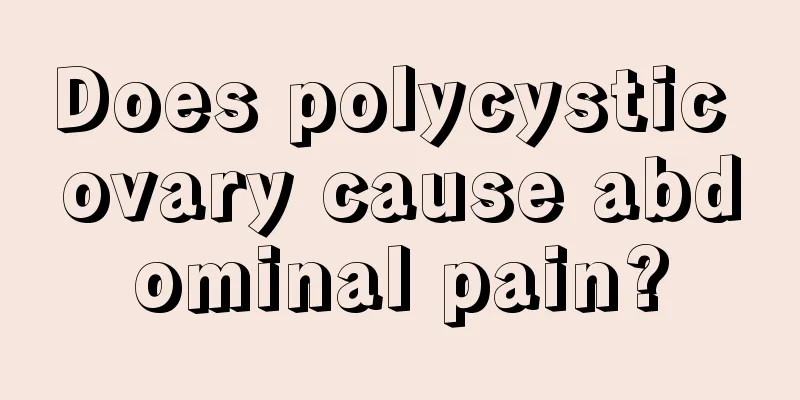Does polycystic ovary cause abdominal pain?

|
Polycystic ovaries mostly occur in women of childbearing age, usually due to endocrine disorders and metabolic abnormalities. There are basically no obvious symptoms in the early stage, and it is often discovered in the late stage. The cysts are usually multiple cysts, so it is called polycystic ovary. This disease can cause menstrual disorders, amenorrhea, vaginal dryness and other problems. So will polycystic ovaries cause lower abdominal pain? What causes polycystic ovary? The cause of polycystic ovary is still unclear. Generally speaking, this type of disease is a congenital multi-gene disease and is also closely related to later lifestyle. For example, long-term consumption of high-calorie or high-fat diets, lack of exercise, and high blood lipids and blood sugar may induce symptoms of polycystic ovary. In addition, the vicious cycle causes the symptoms of polycystic ovary to gradually worsen. In terms of treatment, it is necessary to break the vicious cycle and control the disease through lifestyle changes. Clinical manifestations of polycystic ovary 1. Menstrual disorders. The main clinical manifestations are amenorrhea, oligomenorrhea and functional uterine bleeding, accounting for 70% to 80% of women with abnormal menstruation, 30% of secondary amenorrhea, and 85% of anovulatory functional uterine bleeding. Due to the patient's ovulatory dysfunction and lack of cyclical progesterone secretion, the endometrium is under simple high estrogen stimulation for a long time. Continuous endometrial hyperplasia is prone to simple endometrial hyperplasia, abnormal hyperplasia, and even atypical endometrial hyperplasia and endometrial cancer. 2. Clinical manifestations related to hyperandrogenism. For example, hirsutism, hyperandrogenic acne, female pattern hair loss (FPA), seborrhea and masculinization, etc. 3. Polycystic ovary (PCO). Although a lot of research has been done on the ultrasound diagnostic criteria for PCO, there are still many different opinions. In addition, racial differences make it even more difficult to unify the diagnostic criteria. 4. Other manifestations. For example, obesity, infertility, obstructive sleep apnea, and depression. Therefore, the cause of polycystic ovary is still unclear, but congenital factors and acquired lifestyle have a great relationship with the onset of this disease. If you suffer from polycystic ovary, it is recommended to go to the hospital in time to receive regular treatment. In addition, you should pay attention to the regularity and health of your lifestyle. |
<<: Does ovarian cyst cause stomach pain?
>>: What are the consequences of removing the ovaries?
Recommend
What is the structure of the breast?
Nowadays, many women pay special attention to bre...
International Amyloidosis Day│ No more than 10 cases per million people! What is the rare "amyloidosis"?
Systemic light chain (AL) amyloidosis is a rare d...
What are the symptoms of mild urinary tract infection in women?
The structure of the female urinary tract is some...
Do you know what are the benefits of eating eggs every morning?
Eggs are a nutritious food that is inexpensive an...
My diet is already very light, so why was I diagnosed with high blood lipids?
Contributed by "Cat Doctor Comics"...
What gifts do women like? What gifts are good for women on their birthdays?
Every girl likes to be given gifts because they l...
What should I do if my wife is a barren woman?
Sexual life is the most important part of life. I...
What are the symptoms of bad uterus on the face?
The uterus is the representative of women and is ...
What to do if the fetus is in an abnormal position and the umbilical cord is wrapped around the neck
After a woman becomes pregnant, she needs to go t...
Can I eat blended oil during menstruation?
There are many important stages in a woman's ...
What should I do if my vaginal discharge turns yellow when I am pregnant?
Normal leucorrhea is colorless or white, with no ...
Vulvar leukoplakia can be treated with Chinese medicine
The problem of vulvar leukoplakia is quite common...
What kind of meat is crab steak? Is crab steak seafood?
Crab steak is a crab-flavored fish cake made from...
The pros and cons of girls joining the military
The country's prosperity, strength and territ...
What tests should be done before pregnancy?
I believe that many female friends will hear abou...









